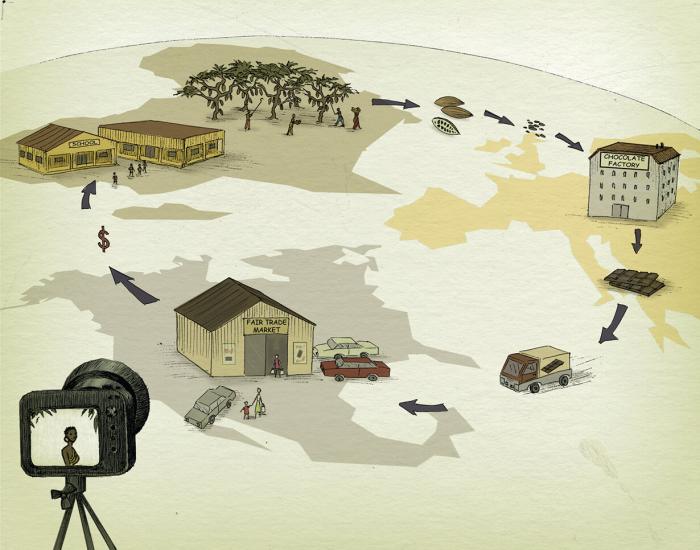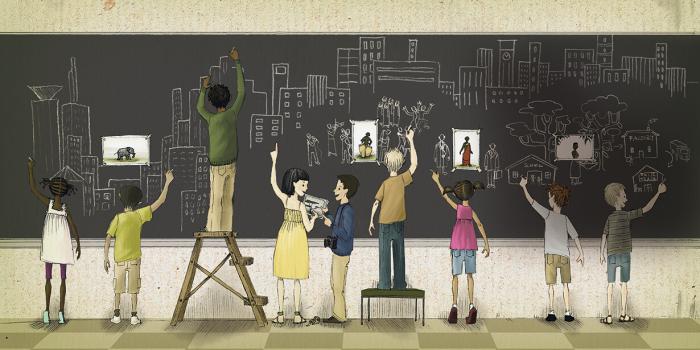In the fall of 2007, in a 1st- and 2nd-grade classroom during circle time, Ms. Brown told her students, "My friend is planning a trip to the continent of Africa. Can you tell me what my friend will need when she goes to Africa?" Several children shouted out excitedly.
Water, 'cause it's very hot.
Food, 'cause they'd be hungry.
A tent.
Ms. Brown followed up with another question, "What will my friend see when she goes to Africa?" The children quickly rattled off a list:
Animals.
Yeah, animals.
Elephants.
Cheetahs and monkeys.
Lions.
Giraffes.
Jaguars.
Men with spears hunting animals.
Ms. Brown asked, "What kinds of things do they do there?"
Dance.
Sing.
Go on a safari.
Finally, Ms. Brown asked, "What kind of jobs do they have there?" The children seemed stumped. Then two children piped up.
Picking fruit.
Growing corn.
These responses highlight the images that children often have of Africa.
As Professor Michael Bamidele Adeyemi of the University of Botswana suggests, "Americans believe that Africa is a country, that Africa is 'still uncivilized,' that the average African is polygamous, and that Africa is not urbanized." In fact, the African continent encompasses a diverse set of more than 50 nations, each made up of a variety of urban and rural cultures, lifestyles and socioeconomic realities. Rates of urbanization in Africa are the highest in the world. By 2025, more than half of the African population will be urban. Barbara Brown explains in the March/April 2008 issue of Social Studies and the Young Learner: "Americans are often surprised to learn that the majority of Africans have never seen large wildlife."
Images in the news, popular media and school textbooks often highlight African people living in abject poverty; rarely do they show the realities of wealth, power and good health that also exist throughout the continent. Typically, African children are depicted as sick and hungry; rare are depictions of the millions of African children who arrive at school fed and ready to learn each day.
Inaccurate impressions of Africa start early, as children are exposed to stereotypical information in books, the news media, advertisements, and film and TV programs such as "The Lion King," "Madagascar" and "George of the Jungle," to name just a few.
It is not just children who see Africa as a land full of wild animals and starving children. One of the authors of this article showed slides in her child's classroom of their family's trip to the capital city of Dakar in Senegal, with images of cars, tall buildings and people in schools, restaurants and at work. As soon as the slide show was over, the teacher jumped in front of the class and told all the students, "I want you to know that this is not the real Africa that you have just seen here."
Because teachers, parents, and other adults are influenced by ongoing exposure to these stereotypes, we must carefully examine and challenge our own knowledge and assumptions about African environments, customs, traditions and cultural realities. Otherwise, our misimpressions influence the kinds of learning opportunities we create for children.
This is a challenging but essential task. Vivian Yenika-Agbaw, the author of Representing Africa in Children's Literature: Old and New Ways of Seeing, analyzed 50 fictional children's books set in West Africa and published between 1960 and 1995. She found that the texts "represent West Africa as either primitive/barbaric or natural/romantic."
She also examined messages regarding life in Africa as depicted in picture books for young children. Although some picture books depicted "Africans as dignified people with varied cultures," many painted a more stereotypical picture; negative messages included descriptions and depictions of Africa "as a 'Mythical Home' with unexplainable natural and historical occurrences … as a vulnerable place prone to foreign invasions … [and] as a place where people share space with animals."
Our own review of 30 children's books about Africa found skewed and incomplete images. More than 90 percent of the books, for example, showed only rural or village life and jungles. Based on images from these books, readers would assume there are no cities in Africa.
Why is this important?
Stereotypical representations of Africa and its people have a profound impact on three levels:
Racial relations and identity development for all Americans.
Constant association of Africa with animals, poverty and exotic behaviors affects the perception of African American and black heritage around the world. Such deficit images of Africa contribute directly to racism. Historically, these misconceptions were used to justify enslavement and colonialism. The portrayal of Africa in Western media and children's books continues to feed a belief in white superiority and the need of Africans (Blacks) to be saved or feared. The images also contribute directly to internalized racism, leading many black children in the U.S. to want to distance themselves from any association with their African heritage.
Treatment of first-generation African immigrants.
Most recent immigrants from African countries to the United States learn quickly about how little Americans know about Africa and experience firsthand the racism associated with that ignorance. We have heard countless stories from first-generation immigrants from Africa about the questions they receive. Invariably, they are asked about wild animals. Many of these immigrants have come from cities in Africa and have not seen a wild animal except in the zoo. In some cases, children are taunted, told to return to the jungle or asked to show their tail.
Global/international relations and foreign policy.
Ultimately what students in the United States learn about Africa impacts our country's relations with and policies toward African countries. If negative stereotypes prevail, then as citizens we are unlikely to challenge policies that are paternalistic or exploitative. If the next generation of students develops a deeper and more respectful understanding of African countries, then our foreign relations and policies will follow suit.
Challenging African Stereotypes in the Classroom
Below are recommendations for using an anti-bias curricular approach when creating learning experiences about the African continent for children in the United States.
Use the names of specific countries instead of just calling it "Africa."
Just as it is unusual to use "Europe" when referring to France or "North America" when referring to Canada, avoid using "Africa" to stand for individual African countries. Some guidance: Some children's books have Africa in the title, but the author's note indicates which nation is featured. If a parent, fellow teacher, or guest speaker references Africa, you can ask: "Which country?" If there are first-generation immigrants from the African continent in your school or classroom, be sure that you and your students know their specific countries of origin. Read Africa is Not a Country (Burns & Melnicove, 2000) to your students, and find the featured countries on a map of Africa. Reinforce the vastness of the continent with the informative map "How Big is Africa," which fits Europe, China and the United States into Africa.
Avoid activities that perpetuate stereotypes of hungry and poor Africans.
Activities that use images of hungry, helpless Africans reinforce negative stereotypes that pervade children's consciousness due to limited exposure to counter images. When fundraising drives, social studies lessons or current events focus on issues of poverty in an African country, use the opportunity to teach about the root causes of hunger and poverty globally. Be sure to help children recognize that poverty is also prevalent here in the United States, and that poverty locally and globally is impacted by U.S. trade policies and multinational corporations. Students can then identify strategies for lasting change, e.g. purchasing fair-trade items, educating their communities, and advocating for progressive legislation. Terry Moore, a 3rd-grade teacher, describes how a small group of committed students moved their school "from charity drives to education to action." For their final project, the students held a Hunger Banquet, an activity designed by Oxfam America to mimic inequities and politics in the real world. Students charged $5 admission to an ice cream banquet, then dished out unequal portions to the attendees. The activity dramatically changed the way their fellow students viewed hunger and poverty. The money the students raised was donated to an organization dedicated to helping people obtain a sustainable source of food and income ("Beyond Bake Sales: Elementary Students Fight Hunger and Child Labor" in Rethinking Schools, Summer 2004). Many more lessons like this can be found in Rethinking Globalization: Teaching for Justice in an Unjust World.
Use "regular" language.
Employ words and phrases that you would normally use when discussing life in the U.S. Use "house" not "hut" and "people" (or identity group or ethnic group) instead of "tribe." The latter is a source of endless debate and discussion. Curtis Keim provides a cogent critique of the term "tribe" in his book Mistaking Africa: Curiosities and Inventions of the American Mind (Keim, 1999).
Pay attention to the messages and images conveyed by your choice of art activities.
In many classrooms, making "African" masks and "huts" are students' first school-based introductions to Africa. Expand students' perspectives by introducing contemporary art and artists. Highlight Nigerian batik specialist Nike Onlaniyi Davies and encourage students to use her techniques to create their own artistic expressions. Davies is featured in Faces magazine's "The Yoruba People: Nigeria and Beyond" (September 1995) and on her website. If mask-making is an essential part of your curriculum, be sure to include masks from throughout the world. Know the country and cultural significance of the masks you are introducing from Africa and be aware that some countries in Africa have no masking traditions. Introduce students to the wide variety of musical expressions from Africa by playing compact discs while students work. Start with Putumayo's "Mali," which features the lyrical kora, the vibrant balaphon and blues-tinged sounds from southern Mali.
Make sure you are using as many contemporary stories as you are folktales.
African folktales are a great way to teach values and gain insight into cultures and beliefs. The heavy use of folktales, however, can lead to misconceptions since folktales are typically set in the past and feature wild animals and rural scenes. Balance folktales with stories that introduce young children to present-day reality in cities and towns. These images are represented well in Ikenna goes to Nigeria (Onyefulu, 2007) and A Child's Day in a South African City (Wulfsohn, 2002).
Include North Africa.
Don't separate the study of North African countries from countries south of the Sahara. Bring North Africa into your discussions with The Day of Ahmed's Secret (Heide & Gilliland, 1990), set in Egypt, and My Father's Shop (Ichikawa, 2006), set in Morocco. When studying ancient Egypt, be sure to include ancient Nubia, Egypt's southern neighbor. The Rise of the Golden Cobra (Aubin, 2007), a novel set during the reign of King Piankhy, is a good choice for upper elementary students.
Highlight typical social groups and everyday activities.
Avoid materials that emphasize exotic practices. Provide posters and books that feature African children and families engaged in everyday activities, especially those activities with which children in the U.S. can relate. The African continent is a diverse collection of countries where people live in wealth and in poverty, in rural and in urban dwellings; where livelihoods depend upon farming, business, and industry; and where individuals occupy all of the professions we have come to associate with the industrialized world, including doctors, lawyers, and professors. Tololwa Mollel's My Rows and Piles of Coins (1999) and Big Boy (1997) are much more representative of life in Tanzania than the endless stream of books about East Africa's cattle-keeping Maasai. For occupation diversity, ask children to identify the different occupations in Here Comes our Bride (Onyefulu, 2004).
Avoid wild animal motifs.
Did you know that most Africans have never seen large wild animals? Elephants, lions and giraffes populate only a few countries, primarily in East and Southern Africa, and today most of these large animals live in or near national parks. Children in Africa are much more likely to see the same animals an American child would see. I Lost My Tooth in Africa (Diakite, 2006), What's Cooking, Jamela? (2001) and Musa's Journey (Grobler, 1997) collectively feature birds, dogs, cats, chickens and a host of other barnyard animals. If "wild animals" is a must-do theme, read a book about wild animals in the U.S., and then read Home Now (Beake, 2007), a realistic story about an orphaned South African girl who befriends an orphaned elephant that lives in a national park. In Ashraf of Africa (Mennen and Daly, 1990), we see fierce lions, gliding crocodiles, and thundering zebras but discover that Ashraf, who lives "in a city, a city at the very tip of the great African continent," has only seen these animals in a book.
Explore African perspectives and actions.
Share the ways Africans see their world by reading award-winning books by African authors. Tololwa Mollel (Tanzania), Ifeoma Onyefulu (Nigeria) and Elinor Sisulu (South Africa) are just a few of the authors from African countries who have won Children's Africana Best Book Awards (complete list of winners at www.AfricaAccessReview.org). Highlight Africans who organized to bring about needed change. For example, students can learn about Kenya's Green Movement and the leadership of Nobel Peace Prize winner Wangari Maathai. Independent readers can tackle easy-to-read biographies including Lilian Ngoyi (van Wyk, 2003) and Helen Joseph (van Wyk, 2003); these unsung heroes — one black, one white – opposed apartheid side by side and in death are buried side by side.
Take an imaginary city tour.
To ensure that your students never say, "I didn't know there were cities in Africa," pretend your class is taking a trip that includes a tour of two or more cities. Students will need to plan their air travel, select hotels, understand the currency and exchange rate, pack appropriate clothing and identify places of interest to visit. Good choices for this project are: Accra, Ghana; Cairo, Egypt; Addis Ababa, Ethiopia; and Cape Town, South Africa. Cape Town (Stein, 1998) and Cairo (Stein, 1996) are good resources for planning trips to these cities. For Accra and Addis Ababa, use Google Images and the University of Wisconsin's digital collection Africa Focus: Sights and Sounds from Africa. Don't limit your study of urbanization in Africa to the present. Ask students in grades 3 and higher to write about living in an ancient or medieval African city. UNESCO's World Heritage site has useful information on Aksum and Lalibela, Ethiopia, and medieval Timbuktu, Mali.
Brenda Randolph is the Director of AfricaAccess, Chairperson of the Africana Children's Book Award and Library Media Specialist with the Montgomery County Maryland Public Schools. Betsy DeMulder is the Director of Initiatives in Educational Transformation at George Mason University and visiting scholar with Teaching for Change. Thanks to Barbara Brown (Boston University), Lindsey Allard (Teaching for Change), Merry Merryfield (Ohio State University), and Deborah Menkart (Teaching for Change) for their contributions to the article.





0 COMMENTS